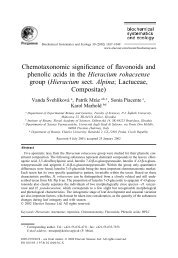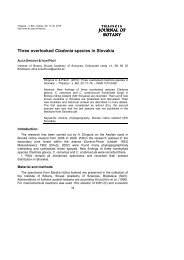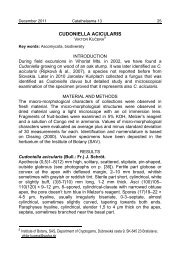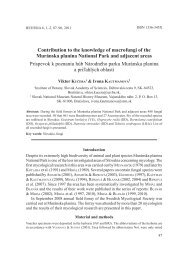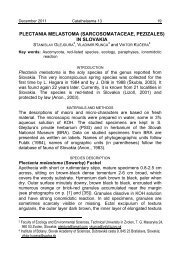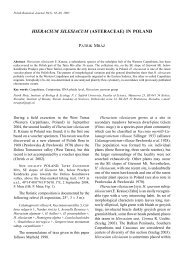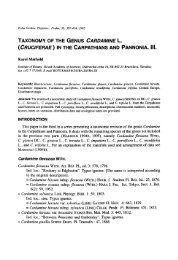Typification of the Linnaean names of the genus - institute of botany ...
Typification of the Linnaean names of the genus - institute of botany ...
Typification of the Linnaean names of the genus - institute of botany ...
You also want an ePaper? Increase the reach of your titles
YUMPU automatically turns print PDFs into web optimized ePapers that Google loves.
LINNAEAN NAMES OF THE GENUS CARDAMINE<br />
all attempts to find <strong>the</strong> specimen on which <strong>the</strong> illustration in Boccone’s work is (or<br />
might be) based in <strong>the</strong> herbaria BOLO, P, GE, IBF, L, LY, OXF, and in <strong>the</strong><br />
Austrian National Library, Vienna (dr. E. Vitek, pers. comm.) (where <strong>the</strong> Boccone<br />
specimens are placed according to Stafleu & Cowan, 1976: 147 and Lanjouw &<br />
Stafleu, 1954: 60) were not successful ei<strong>the</strong>r.<br />
The last cited work in <strong>the</strong> protologue is Bauhin’s Pinax (1623). In <strong>the</strong> case <strong>of</strong><br />
Linnaeus’s references to this work, <strong>the</strong> Burser herbarium is usually consulted.<br />
However <strong>the</strong> volume V <strong>of</strong> this herbarium in which <strong>the</strong> specimen named “Nasturtium<br />
alpinum Resedae foliis Bauh.” was originally placed (Juel, 1936: 30) was destroyed by<br />
fire in Uppsala in 1707 (Juel, 1936: 2) and thus it was not studied by Linnaeus.<br />
After consideration <strong>of</strong> all elements in <strong>the</strong> protologue, and in <strong>the</strong> absence <strong>of</strong> any<br />
relevant herbarium specimen, <strong>the</strong> illustration from Bauhin’s Prodromus <strong>the</strong>atri botanici<br />
(1620: 45) captioned “Nasturtium alpinum minus Resedae foliis” is selected here as<br />
<strong>the</strong> lectotype <strong>of</strong> <strong>the</strong> name Cardamine resedifolia L. However, as this illustration is<br />
demonstrably ambiguous and cannot be critically identified for purposes <strong>of</strong> <strong>the</strong><br />
precise application <strong>of</strong> <strong>the</strong> name <strong>of</strong> a taxon, <strong>the</strong> following epitype is proposed here in<br />
<strong>the</strong> sense <strong>of</strong> <strong>the</strong> Art. 9.7 <strong>of</strong> <strong>the</strong> ICBN: “Pyrenäen orient.: Porté-Puymorens - Vallée<br />
de Lanous, E und W Col de Lanoux, c. 2400 m, im Silikatschutt; 4. VIII. - 17. VIII.<br />
1974, leg. A. Polatschek”, deposited in herbarium W. This specimen documents <strong>the</strong><br />
chromosome number report (2n = 16) <strong>of</strong> Polatschek (1983: 130).<br />
Cardamine trifolia L., Species plantarum: 654, 1753. - LT (designated here): LINN 835.7<br />
[Fig. 2].<br />
The protologue (Linnaeus, 1753: 655) has <strong>the</strong> following elements:<br />
5. CARDAMINE foliis ternatis obtusis, caule subnudo.<br />
Cardamine foliis ternatis. Hall. helv. 559. Fl. suec. 563.<br />
Cardamine foliis ternatis crenatis, caule simplici. Fl. lapp.<br />
257. Hort. cliff. 336. Roy. lugdb. 346.<br />
Cardamine alpina trifola. Clus. hist. 2. p. 127.<br />
Nasturtium alpinum trifolium. Bauh. pin. 104.<br />
Habitat in Alpibus Helveticis, Lapponicis.<br />
Linnaeus mentioned this plant for <strong>the</strong> first time in his Flora lapponica (Linnaeus, 1737:<br />
213). The data concerning <strong>the</strong> occurrence in Lapland (“Est planta mere alpina, in<br />
Lapponia rarius obuia”) seem to be based on Rudbeck (1720–1724: 96), who<br />
reported this taxon from his journey through Lapland in 1695. No specimen<br />
documenting this taxon exists in Linnaeus’s Lapland herbarium in Paris (Fries,<br />
1861). In his Flora suecica Linnaeus (1745) reported “563. Cardamine foliis ternatis”<br />
among <strong>the</strong> plants occurring in “Alpes Lapponicas, quae ab occidentali &<br />
septentrionali latere Norvegiam a Suecia distinguunt” (Linnaeus, 1745: I) and gave<br />
its occurrence as “Habitat in Lapponia. O. Rudbeck. in monte Kinnekulle Westrogothiae.<br />
P. Kalm.”. However, again no specimen in any <strong>of</strong> <strong>the</strong> <strong>Linnaean</strong> herbaria seems to be<br />
connected with <strong>the</strong>se records. The herbarium specimen deposited in <strong>the</strong> <strong>Linnaean</strong><br />
herbarium in London (no. 835.7), bearing Linnaeus’s inscription “5 trifoliata” at <strong>the</strong><br />
bottom <strong>of</strong> <strong>the</strong> sheet has an “urn” label at <strong>the</strong> bottom <strong>of</strong> <strong>the</strong> plant, which suggests that<br />
it might be a duplicate from <strong>the</strong> Clifford herbarium at BM (or ano<strong>the</strong>r Dutch<br />
herbarium <strong>of</strong> 18th century, cf. Wijnands & Heniger, 1991) and <strong>the</strong> specimen is<br />
probably connected, like ano<strong>the</strong>r in <strong>the</strong> Clifford herbarium, with Linnaeus’s Hortus<br />
cliffortianus. Indeed, both plants undoubtedly belong to what is generally considered<br />
127



